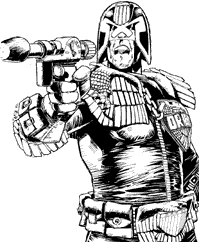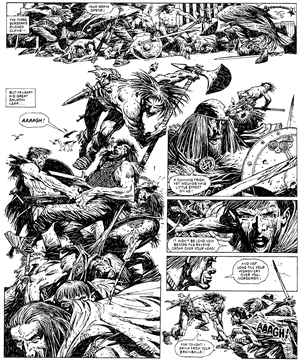
"Judge Dredd", 1980
Michael (known as Mike or Mick) McMahon studied graphic design and illustration at Chelsea School of Art. He showed samples to the editor of Battle Picture Weekly, who put him in touch with an agency who got him work with DC Thomson on a science fiction comic that never came out. Inspired by Paul Neary's work on Eerie, he pencilled some fantasy samples. His agent took them to 2000 AD, which was in pre-production and looking for artists for "Judge Dredd". The character had been designed by Carlos Ezquerra, and McMahon's style was similar enough to Ezquerra's, so he was hired. The first "Dredd" story published was a McMahon one, which so upset Ezquerra that he quit and returned to work for Battle.
The more McMahon drew the more his own style emerged. His drawings became more angular and less organic than Ezquerra's; where Equerra's line was fluid, McMahon's was sharp. Before long McMahon became the character's most regular artist. Other artists, such as Ian Gibson and Brian Bolland, followed his lead, putting their own spin on the way McMahon was developing the character and his world. McMahon's early work was characterised by a quick, spontaneous approach that verged on the messy. His figures were lean and loose, his pen lines thrown down with verve and energy, and hatching was done with a fully-charged brush. He drew the bulk of the first long-form Judge Dredd story, "The Cursed Earth", with the slower, more meticulous Bolland contributing occasional episodes.
In 1979 McMahon took some time off from Dredd to draw Pat Mills's robot disaster squad "Ro-Busters" and its spin-off "ABC Warriors", alternating with Kevin O'Neill and others, and under O'Neill's influence his work became tighter and his figures chunkier. He returned to Dredd the following year for the next long story, "The Judge Child", with a different, more considered style, and rotated with Bolland and Ron Smith. Writers John Wagner and Alan Grant gave McMahon the spookier, more atmospheric episodes to draw, and he responded with subtle lighting, texture and composition effects.
Following "The Judge Child" his art took a high contrast black and white direction, and in colour stories in annuals, explored patterns of flat colour. In 1981, when he began the Judge Dredd story "Block Mania", which he was slated to draw all nine episodes of, his drawings were tight and precise with well-defined areas of black and white. They looked fantastic, but they were taking an increasingly long time to draw, especially with all the crowd scenes the scripts called for, and McMahon bowed out after only two episodes. The story was completed by Smith, Steve Dillon and Bolland, and was followed by the 26-part "Apocalypse War", Carlos Ezquerra's triumphant return to the character he created, which he drew solo.

"Sláine", 1984
McMahon moved to Mills' new Celtic barbarian fantasy, "Sláine", another story with a fraught pre-publication history, and all but disappeared from publication for nearly two years (He did draw a couple of stories for Doctor Who Magazine during this time). When he did return in 1983, it was with a radically different style, all sinuous figures, tangled pen lines, and incompletely filled in areas of black. Freed from sterile science fiction environments, he went to town on texture and tone, lashed together technology and gloriously organic backgrounds.
After his last work on Sláine in 1984, McMahon did another of his vanishing and evolving acts. He re-emerged in 1991, after a long illness that prevented him from drawing, with The Last American, written by Wagner and Grant, for Marvel Comics' Epic imprint in the USA, and another radical change in drawing style. The Last American is Ulysses Pilgrim, a disgraced US Army officer placed in suspended animation on the eve of a nuclear war and authorised to restore order after it - but when he's revived he discovers there's nothing to restore order to. For four issues he searches in vain for survivors, accompanied by three slightly deranged robots, and struggling not to succumb to despair. McMahon's art is blocky, all straight, edgy lines and enclosed, flat areas of deep, vivid colour, stylised yet straight-faced, perfectly straddling the low-key realism of the story and Pilgrim's increasingly desperate mental state.
Since then he has worked in computer game design and his work in comics has been sporadic. A couple of Hellraiser stories, an Alien Legion one-off, the unfinished "Mutomaniac" in the short-lived weekly Toxic!, a handful of Judge Dredd-related stories, and a daring futuristic Batman story in Legends of the Dark Knight, saw him progressively simplify and flatten his style, then find new ways of introducing depth in Sonic the Comic, the miniseries Tattered Banners for DC's Vertigo imprint, a return to "ABC Warriors" and a short Batman Black and White back-up story. During this time, he also produced two visually striking 6 page strips for the Marvel UK/Panini fortnightly comic Rugrats. He would have been commissioned to draw more, but the comic was canceled. His latest work, a Judge Dredd episode, appeared in 2000 AD prog 1539. He is currently working on a Tank Girl miniseries, "Carioca", with Tank Girl co-creator Alan Martin for Titan Books.
McMahon's work never sits still, but frequently goes beyond comics fans' stylistic comfort zones. His influences include Victor de la Fuente, Hugo Pratt, Gino d'Antonio, Don Lawrence, Joe Colquhoun and Harvey Kurtzman.
External links[]
References[]
- Interview with Masters of Infinity, 1980
- Colin M Jarman & Peter Acton (1995), Judge Dredd: The Mega-History
- David Bishop (1995), "Mike McMahon" (interview), The Complete Judge Dredd Special Edition No. 2
- Patrick Brown (1996), "Mike McMahon", The Panelhouse issue 4 pp. 19–22
- Interview with Class of 79
- David Bishop (2002–2003), "Thrill Power Overload", Judge Dredd Megazine vol 4 issues 9-18, issues 201-209
Online reference[]
Mike McMahon on Wikipedia
 Mike McMahon at the Comic Book DB
Mike McMahon at the Comic Book DB